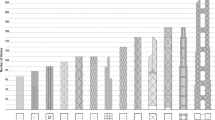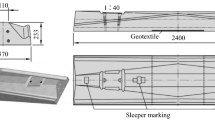Abstract
The welding heat source models and the plastic tension zone sizes of a typical weld joint involved in the double floor structure of high speed train under different welding parameters were calculated by a thermal-elastic-plastic FEM analysis based on SYSWELD code. Then, the welding distortion of floor structure was predicted using a linear elastic FEM and shrinkage method based on Weld Planner software. The effects of welding sequence, clamping configuration and reverse deformation on welding distortion of floor structure were examined numerically. The results indicate that the established elastic FEM model for floor structure is reliable for predicting the distribution of welding distortion in view of the good agreement between the calculated results and the measured distortion for real double floor structure. Compared with the welding sequence, the clamping configuration and the reverse deformation have a significant influence on the welding distortion of floor structure. In the case of 30 mm reverse deformation, the maximum deformation can be reduced about 70% in comparison to an actual welding process.
Similar content being viewed by others
References
Zhu, R.D., Dong, W.C., Lin, H.Q., et al.: Finite element simulation of welding residual stress for buffer beam of CRH2A high speed train. Acta Metall. Sin. 50, 944–954 (2014)
Yao, S.B., Sun, Z.X., Guo, D.L., et al.: Numerical study on wake characteristics of high-speed trains. Acta Mech. Sin. 29, 811–822 (2013)
Yu, H.H., Li, J.C., Zhang, H.Q.: On aerodynamic noises radiated by the pantograph system of high-speed trains. ActaMech. Sin. 29, 399–410 (2013)
Ueda, Y., Yamakawa, T.: Analysis of thermal elastic-plastic stress and strain during welding by finite element method. Trans. Japan Weld. Soc. 2, 90–100 (1971)
Hibbitt, D.H.: A numerical, thermo-mechanical model for the welding and subsequent loading of a fabricated structure. Comput. Struct. 3, 1145–1174 (1973)
Friedman, E.: Thermomechanical analysis of the welding process using the finite element method. J. Pressure Vessel Technol. 97, 206–213 (1975)
Lindgren, L.E., Karlsson, L.: Deformations and stresses in welding of shell structures. Int. J. Numer. Meth. Eng. 25, 635–655 (1988)
Michaleris, P., Debiccari, A.: Prediction of welding distortion. Weld. J. 76, 172–180 (1997)
Tsirkas, S.A., Papanikos, P., Pericleous, K., et al.: Evaluation of distortions in laser welded shipbuilding parts using localglobal finite element approach. Sci. Technol. Weld. Joining 8, 79–88 (2003)
Duan, Y.G., Vincent, Y., Boitout, F., et al.: Prediction of welding residual distortions of large structures using a local/global approach. J. Mech. Sci. Technol. 21, 1700–1706 (2007)
Nishikawa, H., Serizawa, H., Murakawa, H.: Actual application of FEM to analysis of large scale mechanical problems in welding. Sci. Technol. Weld. Joining 12, 147–152 (2007)
Wang, R., Zhang, J.X., Serizawa, H., et al.: Study of welding inherent deformations in thin plates based on finite element analysis using interactive substructure method. Mater. Des. 30, 3474–3481 (2009)
Cai, Z., Zhao, H., Lu, A.: Efficient finite element approach for modelling of actual welded structures. Sci. Technol. Weld. Joining 8, 195–204 (2003)
Ueda, Y., Fukuda, K., Nakacho, K., et al.: A new measuring method of residual stresses with the aid of finite element method and reliability of estimated values. Trans. JWRI 4, 19–27 (1975)
Luo, Y., Deng, D., Xie, L., et al.: Prediction of deformation for large welded structures based on inherent strain. Trans. JWRI 33, 65–70 (2004)
Murakawa, H., Ueda, Y., Luo, Y.: Prediction of welding deformation and residual stress by elastic FEM based on inherent strain. First report: Mechanism of inherent strain production. J. Soc. Nav. Archit. Japan 180, 739–751 (1996)
Liang, W., Deng, D., Sone, S., et al.: Prediction of welding distortion by elastic finite element analysis using inherent deformation estimated through inverse analysis. Weld. World 49, 30–39 (2005)
Deng, D., Murakawa, H.: Numerical simulation of welding distortion in large structures. Comput. Methods Appl. Mech. Eng. 196, 4613–4627 (2007)
Deng, D., Murakawa, H.: FEM prediction of buckling distortion induced by welding in thin plate panel structures. Comput. Mater. Sci. 43, 591–607 (2008)
Wang, J.C., Ma, N., Murakawa, H., et al.: Prediction and measurement of welding distortion of a spherical structure assembled from multi thin plates. Mater. Des. 32, 4728–4737 (2011)
Wang, J.C., Rashed, S., Murakawa, H., et al.: Numerical prediction and mitigation of out-of-plane welding distortion in ship panel structure by elastic FE analysis. Mar. Struct. 34, 135–155 (2013)
Bachorski, A., Painter, M.J., Smailes, A.J., et al.: Finite element prediction of distortion during gas metal arc welding using the shrinkage volume approach. J. Mater. Process. Technol. 92–93, 405–409 (1999)
Jackson, K., Darlington, R.: Advanced engineering methods for assessing welding distortion in aero-engine assemblies. IOP Conf. Series: Mater. Sci. Eng. 26, 012018 (2011)
Goldak, J., Chakravarti, A., Bibby, M.: A new finite element model for welding heat sources. Metall. Trans. B 15, 299–305 (1984)
Sulaiman, M.S., Manurung, Y.HP., Haruman, E., et al.: Simulation and experimental study on distortion of butt and T-joints using WELD PLANNER. J. Mech. Sci. Technol. 25, 2641–2646 (2011)
Lu, Y., Wu, P., Zeng, J., et al.: Numerical simulation of welding distortion using shrinkage force approach and application. Adv. Mater. Res. 129–131, 867–871 (2010)
SYSWELD. Engineering Guide of Training and Toolbox. ESI Group, France (2012)
Author information
Authors and Affiliations
Corresponding author
Rights and permissions
About this article
Cite this article
Dong, WC., Lu, SP., Lu, H. et al. Numerical simulation and control of welding distortion for double floor structure of high speed train. Acta Mech Sin 30, 849–860 (2014). https://doi.org/10.1007/s10409-014-0108-8
Received:
Accepted:
Published:
Issue Date:
DOI: https://doi.org/10.1007/s10409-014-0108-8




